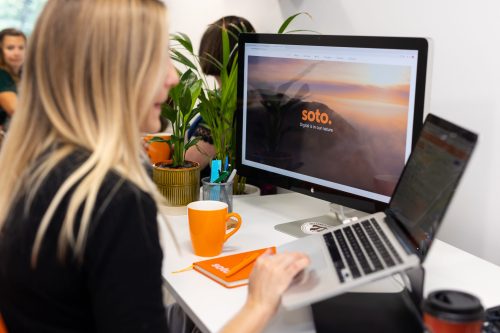Did you know that the internet is responsible for around 4% of the world’s carbon emissions? Considering the web doesn’t directly produce CO2, that’s a shocking statistic, isn’t it? That’s why it’s so important for us all to do our part to make the internet a better, more sustainable place.
The good news is that we’re getting there!
More and more businesses are realising that sustainable web design & development is the way to go. When we’re developing sites at Soto, we always chat with our clients about their plans for design, and they’re increasingly talking to us about things like image optimisation and green hosting.
Amazing!
However, what our clients aren’t talking to us about – at least not in terms of sustainability – is accessibility. And that sort of makes sense. After all, accessibility and sustainability don’t particularly go hand-in-hand… do they?
Well actually, they’re more connected than you might think, and we’re going to show you how.
The Accessibility-Sustainability Connection
Accessible web design & development isn’t yet considered the norm. But it should be. Especially today, at a time when it’s actually pretty difficult to get by without using the internet.
Think about how so many banks are closing their high street branches and shifting to online services. Or how loads of businesses are taking phone numbers off their websites, preferring to use email or video calls. In a world where we’re expected to use the web for everything from buying groceries and booking a fitness class, to learning and finding job opportunities, the web really needs to be accessible to all.
Yet it’s not. There’s so much content out there that can’t be accessed by those living with different abilities, and different limitations. But what’s all this got to do with building a sustainable future?
The link between accessibility and sustainability may not seem clear at first. However, creating accessible sites is all about creating simple sites; sites that can be enjoyed by everyone, regardless of their abilities or limitations. And as we know, simple sites tend to be lighter, faster, and require fewer resources and energy to load. When we look at it like this, the link between the two is obvious.
How to design a website with accessibility & sustainability in mind
Here are 3 top Soto tips for designing websites that are accessible and sustainable:
-
Focus on clean interfaces
Websites with lots of ‘fluff’ are a major accessibility issue for two reasons. Firstly, they can be difficult to read and understand by those with visual or cognitive conditions. Secondly, we need to remember that accessibility isn’t just about making content available to those with disabilities; it’s about making it available to everyone. This includes those without disabilities who still struggle to access websites. For example, those with slow connections. In this instance, ‘fluff’ – things like decorative images or videos – serves no other purpose than increasing already lengthy load times.
When we design with accessibility in mind, we naturally want to remove anything that’s not critical to the experience. This act of reducing waste – and focusing on clean, simple interfaces – is in turn better for the environment, using fewer resources and less energy to load pages.
-
Create a logical structure
Even the savviest of internet users can be flummoxed by poor navigation. If navigation is neither intuitive nor well signposted, it can be difficult to get to where you need to be.
Now imagine just how much more challenging that is for someone who’s not that confident using the web. The result is likely to be a lot of clicking around, landing on pages you didn’t really intend to. In terms of accessibility, there needs to be a clear, logical path from A-B, making it obvious to the user – any user – how they can get from where they are now to the content that they’ve come to the site to view.
When we develop and design in this way, we’re helping to protect the planet, too. We’re working to ensure that any page that loads is meant to be loaded; that it’s intentional, and that we’re not wasting resources through random clicking around desperately trying to find what we need.
-
Offer alternative options
We all have this idea of how our websites will look – and that’s a good thing! It’s always helpful to both developers and designers when you have ideas. However, we also need to remember, acknowledge, and accept that what we think of as being a good website might not be what others do. Rather than saying, ‘It’s our way or the highway’, we should be giving visitors the flexibility to display and use our sites in a way that best suits them. This could mean offering design alternatives, such as dark mode, or alternatives to rich media such as text descriptions.
Not only is this a more inclusive way to build a website, but it also helps save energy on user devices. This is important because, as we explored in our previous blog post looking at how websites create emissions, building a sustainable digital future is a shared responsibility. We all need to do our part.
Empowering communities, protecting the planet
To make content more accessible, we need to build more efficient websites; websites that send a clear message and get to the point quickly without any fuss, with zero bells and whistles. And when we build more efficient sites, we help to reduce the amount of resources required.
So when you’re thinking about how to make a site that can help create a brighter tomorrow, that’s more sustainable and better for our environment, think accessibility. It’s one of the keys to success.





